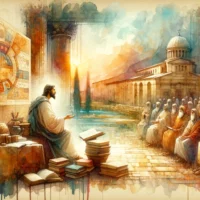Navigating the vast expanse of the Bible can sometimes feel like journeying through an unfamiliar landscape. This is not a solitary journey, but one we undertake together as a community of believers, seeking to understand God’s Word. The aim of this article is to provide practical ways to enrich your reading of the Bible, fostering a deeper understanding of its message and meaning.
The Importance of Prayerful Reading
Prayer forms the foundational pillar of any spiritual endeavor, and reading the Bible is no different. Engaging with the Scriptures in a prayerful spirit can open up new dimensions of understanding. Prayer isn’t just about asking for things; it’s a communication tool that allows us to connect with God on a deeper level. When we approach the Bible with a prayerful heart, we invite God into our reading process, and this can help unlock the transformative power of His Word.
The Bible is God’s revelation to us, His way of communicating His love, His will, and His purpose. So, it’s fitting that we should open our hearts to Him before we begin reading. A simple prayer asking God to guide our understanding can make a significant difference. When we surrender our preconceived notions and ask God to enlighten us, we invite His spirit to guide our understanding (John 16:13).
Regularly coupling Bible reading with prayer is much like having a conversation with the author of a book. It establishes a dynamic relationship between the reader and the text, allowing the Word to speak into our lives and transform us. As we pray, we become more attuned to the voice of God in Scripture, enabling us to grasp the lessons and truths contained therein (1 Corinthians 2:14).
Prayerful reading is not a one-time act but a continuous process. We should approach each reading session as an ongoing conversation with God, inviting His wisdom and understanding into our hearts and minds (Psalm 119:18). This doesn’t mean every verse will instantly make sense, but it does mean we’ll be more open to God’s guidance in our quest for understanding.
Understanding the Bible isn’t merely an intellectual pursuit; it’s a spiritual journey. This journey begins and deepens with prayer. Praying before, during, and after reading the Bible can help us better comprehend God’s Word, fostering a deeper, more personal relationship with Him. By engaging the Scriptures prayerfully, we are in essence inviting God to join us in our reading, allowing His wisdom and insight to illuminate our understanding. This practice sets a solid foundation for the other steps we’ll explore in enhancing our comprehension of the Bible.
Utilizing Context for Enhanced Comprehension
Context is a powerful tool when it comes to reading and understanding the Bible. We can think of context as the scenery surrounding a particular verse or passage, providing necessary background information that helps us grasp the full meaning. The Bible, written over a span of around 1,500 years by various authors and in different cultures, is rich with historical, cultural, and literary context, all of which can impact our understanding.
- Historical context plays a significant role in understanding the events and messages in the Bible. For instance, knowing the political and social dynamics during the time of Jesus can shed light on His teachings and actions. For example, the concept of “turning the other cheek” (Matthew 5:38-39) makes more sense when we understand it was directed at a society where retaliation was common.
- Cultural context is another key piece of the puzzle. The Bible was written in a time and place vastly different from ours. Understanding the customs, beliefs, and norms of the societies in which the Biblical narratives occurred can offer us a clearer picture. One example is Paul’s advice to the Corinthians about head coverings (1 Corinthians 11:2-16). This can seem puzzling to modern readers, but it was a culturally relevant issue in the first-century church in Corinth.
- Literary context is crucial too. The Bible isn’t a single book but a collection of books, letters, and writings of different genres. Some are historical narratives, some are poetry, and some are prophetic writings. The genre impacts how we interpret the text. Reading Psalms, a book of poetry and songs, requires a different approach than reading Romans, a theological letter.
Context helps us to avoid misinterpretation and to draw out the original intended meaning of the text. This doesn’t mean we can’t apply the Bible’s teachings to our current situation, but we need to be aware of the context in which these teachings were given to ensure we are true to their original intent.
The process of considering historical, cultural, and literary contexts when reading the Bible is an essential step in our journey of understanding. By becoming aware of the world in which the Bible was written, we can better grasp its truths and lessons. Context not only helps us understand what the Bible meant when it was written, but also what it means for us today. It’s like having a map that guides us through the foreign landscape of the Bible, illuminating the path towards deeper understanding.
The Role of Regular Reflection and Application
Reading the Bible isn’t a one-way street; it’s an interactive process. This interaction involves not only understanding the text but also reflecting on its meaning and applying its truths to our lives. Reflection and application are the two sides of the same coin, both crucial for a deeper engagement with God’s Word.
Reflection is taking time to ponder on what we’ve read, allowing it to sink into our hearts and minds. It’s about asking questions and seeking answers. What does this passage mean? How does it relate to the broader narrative of the Bible? What is God trying to teach me through this? Reflection moves us from surface reading to a deeper understanding, where we engage with the text intellectually and emotionally. For instance, reflecting on the parable of the Good Samaritan (Luke 10:25-37) may lead us to consider our attitudes towards those different from us.
Application, on the other hand, is about living out the truths we’ve learned. It’s taking the principles, lessons, and wisdom from the Bible and incorporating them into our daily lives. The book of James reminds us that we should not merely listen to the Word, but also do what it says (James 1:22). So, if we read about the importance of forgiveness (Matthew 18:21-22), we should strive to be more forgiving in our interactions with others.
Regular reflection and application can transform our Bible reading from a passive activity into an active engagement. It’s not enough to simply read the words on the page; we need to digest them, mull over them, and let them shape our actions. This involves an ongoing commitment to growth and transformation, as we allow God’s Word to continually reshape our thoughts and behaviors.
The practice of reflection and application serves as the natural progression in our journey of understanding the Bible. They breathe life into our reading, transforming the words on a page into a living, active force in our lives. By regularly reflecting on what we’ve read and applying those truths to our daily lives, we allow the Bible to fulfill its purpose in our lives – to guide, to teach, and to transform us. This practice not only deepens our understanding of God’s Word but also strengthens our relationship with Him, as we continually align our lives with His teachings.
Navigating the Journey of Understanding
Through prayerful reading, paying attention to context, and regularly reflecting and applying, we can approach the Bible with a heart ready to receive and a mind open to understanding. God’s Word is a treasure chest of wisdom, guidance, and love, and these practical steps can help us unlock its riches.
Consider these questions as you embark on your journey of understanding:
- How can I incorporate prayer into my Bible reading routine in a more meaningful way?
- What steps can I take to better understand the context of the passages I read?
- How can I be more intentional about reflecting on and applying the truths I learn from the Bible?
The Bible is more than just a book; it’s a conversation with God that spans the ages. It’s a testament to His love for us and His desire for a relationship with us. And so, let us continue to seek Him in its pages, confident that He will meet us there and guide us into all truth. May our journey of understanding deepen our love for God and for His Word, inspiring us to live out His truths with joy and faithfulness.














